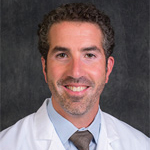
Dr. Fischer
“We don’t want to jump to the conclusion that it’s CTD associated until we’ve done a thorough evaluation to exclude other etiologies,” Dr. Fischer said.
A proper assessment for CTD is crucial because the type of ILD affects both treatment and diagnosis—those with CTD-related ILD tend to do better than those with idiopathic forms.2 Plus, identifying new CTD in patients who present with ILD is fairly common—a 2009 study of 114 consecutive ILD patients found that 30% had well-defined CTD, and, for 17% of patients, the CTD diagnosis was new.3
Those whose ILD might seem “idiopathic” because of a lack of classic symptoms, could, upon a closer look, have systemic sclerosis sine scleroderma—identified by nucleolar ANA antibodies Scl-70 or Th/To antibodies, as well as subtle features of systemic sclerosis, as reported in a study he led in 2006, Dr. Fischer said.
“We tried to highlight to the pulmonary community, ‘When you all are seeing idiopathic NSIP (non-specific interstitial pneumonia), when you’re seeing idiopathic UIP (usual interstitial pneumonia), and you see those subtle features—the nucleolar ANA, the palmar telangiectasia, the puffy hands—even without skin thickening, don’t forget about the scleroderma spectrum,” he said.
Anti-synthetase syndrome can be tricky as well—it can often be a non-Jo and ANA-negative form and present as “idiopathic,” he said. In a study published in 2009, Dr. Fischer and his colleagues identified nine such non-Jo-1 patients, who were identified with different antibodies, such as PL-7 and PL-12.
As for management, Dr. Fischer said that for now, connective tissue disease-related ILD management is not evidence based, but experience based. He said mycophenolate mofetil is a common steroid-sparing option and warrants prospective study. But he emphasized that treatment with immunosuppression is only indicated in those with clinically significant, progressive interstitial lung disease.
“Remember, this is a scenario [in which] patients are dying,” Dr. Fischer said. “And we don’t do a lot of good in terms of improving their lung function. … But we are looking at stabilizing disease.”
The need for better therapies and clinical trials, Dr. Fischer said, is “desperate.”
Drug Toxicity
Kristin Highland, MD, MSCR, who has dual appointments at Cleveland Clinic’s Respiratory Institute and Orthopedics and Rheumatology Institute, said clinicians need to stay vigilant about drug-related lung toxicities, because most medications have at least some potential to be toxic to the lung.
The website, Pneumotox, should be “your friend,” because it ranks the risk of lung toxicity for each drug based on all the reports of toxicity incidence in the literature.
